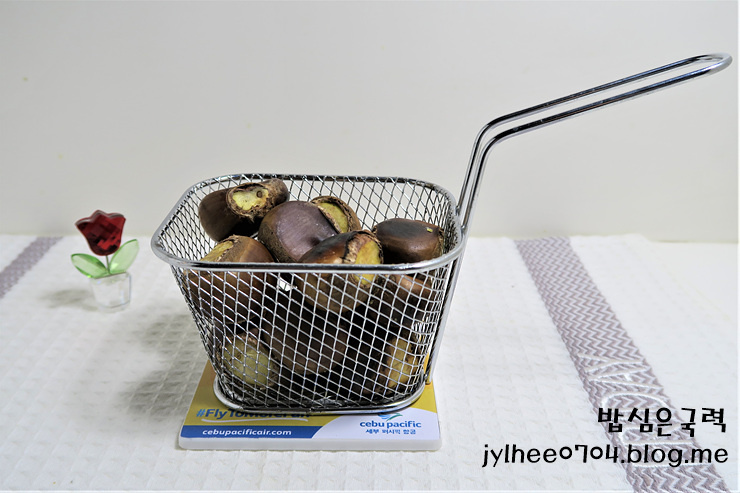Cozy Roasted Chestnuts in a Clay Pot (Ttukbaegi)
Homemade Roasted Chestnuts Using a Ttukbaegi

Chestnuts are in season from September to December, and they are a versatile ingredient, enjoyed raw, as a side dish component, or in baked goods, rice cakes, and preserves. They are considered a high-quality food ingredient and are a staple on traditional Korean ancestral offering tables. Chestnuts are rich in vitamins A and C, which can help with anti-aging and boosting immunity. Choose large, plump, shiny brown chestnuts for the best quality. For storage, seal them in a plastic bag and keep them at 0-1℃. Today, we’ll make delicious roasted chestnuts conveniently at home using a Ttukbaegi (Korean earthenware pot). The gentle, consistent heat from the Ttukbaegi brings out the natural sweetness of the chestnuts beautifully.
Ingredients- 25 fresh chestnuts
Cooking Instructions
Step 1
First, prepare your fresh, carefully selected chestnuts. If they were gifted by a friend from their hometown, they might feel even more special!

Step 2
To prevent the chestnut skins from bursting and to ensure even cooking, it’s important to score the chestnut shells before roasting. This step guarantees safer and tastier roasted chestnuts.

Step 3
Here’s a safe way to prepare the chestnuts: Place a chestnut on a cutting board and use a knife to make shallow scores on both the front and back of the shell. Always protect your hands when using a knife, and avoid holding the chestnut directly while cutting, as this can be dangerous.

Step 4
As you score the shells, you can directly check the freshness of the chestnuts. Fresh chestnuts will have firm shells and feel plump.

Step 5
Now, let’s roast the chestnuts using a Ttukbaegi! Place all the prepared chestnuts into the Ttukbaegi. Set the heat to very low and roast slowly. It’s crucial to cook them gently over low heat rather than high heat.

Step 6
Close the lid of the Ttukbaegi. Earthenware pots are excellent at retaining heat, which helps to cook the chestnuts evenly until they are soft and moist inside. Using an unglazed Ttukbaegi is especially convenient as it ensures no detergent residue remains after washing.

Step 7
As the chestnuts cook, their natural moisture will evaporate, causing water droplets to form on the inside of the lid. This is a sign that the chestnuts are cooking nicely.

Step 8
While roasting, use tongs to flip the chestnuts every 10 minutes for even cooking. The total roasting time is recommended to be around 30 minutes. The exact time may vary slightly depending on your stove’s heat, as well as the size and quantity of the chestnuts. Keep an eye on them and adjust the time as needed.

Step 9
After about 30 minutes of roasting, the chestnut shells might appear slightly blackened. Once cooked, turn off the heat and let the chestnuts steam inside the Ttukbaegi with the lid on for another 5 minutes. The residual heat from the Ttukbaegi will continue to cook them gently, ensuring they remain moist and tender.




